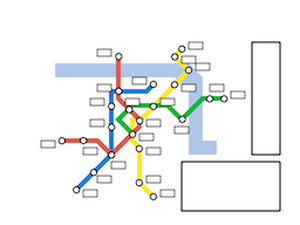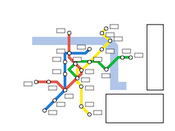Information
- Publication Type: Journal Paper with Conference Talk
- Workgroup(s)/Project(s): not specified
- Date: May 2020
- Journal: Computer Graphics Forum
- Volume: 39
- Open Access: yes
- Number: 3
- Lecturer: Hsiang-Yun Wu

- ISSN: 1467-8659
- Event: EuRoVis 2020
- DOI: 10.1111/cgf.14030
- Call for Papers: Call for Paper
- Pages: 28
- Conference date: 25. May 2020
– 29. May 2020
- Pages: 619 – 646
- Keywords: Computer Graphics and Computer-Aided Design
Abstract
Transit maps are designed to present information for using public transportation systems, such as urban railways. Creating a transit map is a time-consuming process, which requires iterative information selection, layout design, and usability validation, and thus maps cannot easily be customised or updated frequently. To improve this, scientists investigate fully- or semi-automatic techniques in order to produce high quality transit maps using computers and further examine their corresponding usability. Nonetheless, the quality gap between manually-drawn maps and machine-generated maps is still large. To elaborate the current research status, this state-of-the-art report provides an overview of the transit map generation process, primarily from Design, Machine, and Human perspectives. A systematic categorisation is introduced to describe the design pipeline, and an extensive analysis of perspectives is conducted to support the proposed taxonomy. We conclude this survey with a discussion on the current research status, open challenges, and future directions.
Additional Files and Images
Additional images and videos
Additional files
Weblinks
BibTeX
@article{wu-2020-eurovis-star,
title = "A Survey on Transit Map Layout – from Design, Machine, and
Human Perspectives",
author = "Hsiang-Yun Wu and Benjamin Niedermann and Shigeo Takahashi
and Maxwell J. Roberts and Martin N\"{o}llenburg",
year = "2020",
abstract = "Transit maps are designed to present information for using
public transportation systems, such as urban railways.
Creating a transit map is a time-consuming process, which
requires iterative information selection, layout design, and
usability validation, and thus maps cannot easily be
customised or updated frequently. To improve this,
scientists investigate fully- or semi-automatic techniques
in order to produce high quality transit maps using
computers and further examine their corresponding usability.
Nonetheless, the quality gap between manually-drawn maps and
machine-generated maps is still large. To elaborate the
current research status, this state-of-the-art report
provides an overview of the transit map generation process,
primarily from Design, Machine, and Human perspectives. A
systematic categorisation is introduced to describe the
design pipeline, and an extensive analysis of perspectives
is conducted to support the proposed taxonomy. We conclude
this survey with a discussion on the current research
status, open challenges, and future directions.",
month = may,
journal = "Computer Graphics Forum",
volume = "39",
number = "3",
issn = "1467-8659",
doi = "10.1111/cgf.14030",
pages = "28",
pages = "619--646",
keywords = "Computer Graphics and Computer-Aided Design",
URL = "https://www.cg.tuwien.ac.at/research/publications/2020/wu-2020-eurovis-star/",
}


 image
image paper
paper
